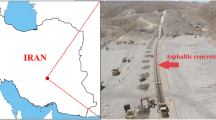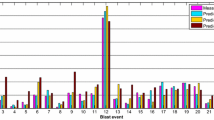Abstract
One of the most challenging safety problems in open pit mines is backbreak during blasting operation, and its prediction is very important for a technically and economically successful mining operation. This paper presents application of particle swarm optimization (PSO) technique to estimate the backbreak induced by bench blasting, based on major controllable blasting parameters. Two forms of PSO models, linear and quadratic, are developed based on blasting data from Sungun copper mine, Iran. According to obtained results, both models can be used to predict the backbreak, but the comparison of two models, in terms of statistical performance indices, shows that the quadratic form provides better results than the linear form.




Similar content being viewed by others
References
Jimeno CL, Jimeno EL, Carcedo FJA (1995) Drilling and blasting of rocks. Balkema, Rotterdam
Rustan A, Cunningham C, Fourney W, Simha KRY, Spathis AT (2010) Mining and rock construction technology desk reference: rock mechanics, drilling and blasting. CRC Press, Boca Raton
Bauer A (1982) Wall control blasting in open pits. In: Proceedings of the 14th Canadian rock mechanics symposium, Vancouver, British Columbia, Canada, May 1982. Canadian Institute of Mining and Metallurgy, CIM Special, vol 30, pp 3–10
Konya CJ, Walter EJ (1991) Rock blasting and overbreak control. United States Department of Transportation, McLean
Konya CJ, Walter EJ (2003) Rock blasting and overbreak control. National Highway Institute, Arlington
Scoble MJ, Lizotte YC, Paventi M, Mohanty BB (1997) Measurement of blast damage. Min Eng 49:103–108
Wyllie DC, Mah CW (2004) Rock slope engineering: civil and mining, 4th edn. Spoon Press, New York
Gate WC, Ortiz BLT, Florez RM (2005) Analysis of rockfall and blasting backbreak problems. In: Proceedings of the 40th US Symposium on Rock Mechanics (USRMS), Anchorage, Alaska, June 2005, vol 5, pp 671–680
Alejano LR, Pons B, Bastante FG, Alonso E, Stockhausen HW (2007) Slope geometry design as a means for controlling rockfalls in quarries. Int J Rock Mech Min Sci 44:903–921
Khandelwal M, Singh TN (2013) Application of an expert system to predict maximum explosive charge used per delay in surface mining. Rock Mech Rock Eng 46:1551–1558
Sari M, Ghasemi E, Ataei M (2014) Stochastic modeling approach for the evaluation of backbreak due to blasting operations in open pit mines. Rock Mech Rock Eng 47:771–783
Monjezi M, Rezaei M, Yazdian A (2010) Prediction of backbreak in open-pit blasting using fuzzy set theory. Expert Syst Appl 37:2637–2643
Monjezi M, Sayadi A, Talebi N (2010) Prediction of backbreak using blasting parameters. J Mine Met Fuel 58(8):223–226
Monjezi M, Ahmadi Z, Yazdian Varjani A, Khandelwal M (2013) Backbreak prediction in the Chadormalu iron mine using artificial neural network. Neural Comput Appl 23:1101–1107
Sayadi A, Monjezi M, Talebi N, Khandelwal M (2013) A comparative study on the application of various artificial neural networks to simultaneous prediction of rock fragmentation and backbreak. J Rock Mech Geotech Eng 5:318–324
Esmaeili M, Osanloo M, Rashidinejad F, Aghajani Bazzazi A, Taji M (2014) Multiple regression, ANN and ANFIS models for prediction of backbreak in the open pit blasting. Eng Comput 30:549–558
Karami AR, Mansouri H, Ebrahimi Farsangi MA, Nezamabadi H (2006) Backbreak prediction due to bench blasting: an artificial neural network approach. J Mine Met Fuel 54(12):418–420
Monjezi M, Dehghani H (2008) Evaluation of effect of blasting pattern parameters on back break using neural networks. Int J Rock Mech Min Sci 45:1446–1453
Faramarzi F, Ebrahimi Farsangi MA, Mansouri H (2013) An RES-based model for risk assessment and prediction of backbreak in bench blasting. Rock Mech Rock Eng 46:877–887
Monjezi M, Amini Khoshalan H, Yazdian Varjani A (2011) Optimization of open pit blast parameters using genetic algorithm. Int J Rock Mech Min Sci 48:864–869
Monjezi M, Amini Khoshalan H, Yazdian Varjani A (2012) Prediction of flyrock and backbreak in open pit blasting operation: a neuro-genetic approach. Arab J Geosci 5:441–448
Faradonbeh RS, Monjezi M, Armaghani DJ (2015) Genetic programing and non-linear regression techniques to predict backbreak in blasting operation. Eng Comput. doi:10.1007/s00366-015-0404-3
Ebrahimi E, Monjezi M, Khalesi MR, Armaghani DJ (2015) Prediction and optimization of back-break and rock fragmentation using an artificial neural network and a bee colony algorithm. Bull Eng Geol Environ. doi:10.1007/s10064-015-0720-2
Saghatforoush A, Monjezi M, Faradonbeh RS, Armaghani DJ (2015) Combination of neural network and ant colony optimization algorithms for prediction and optimization of flyrock and back-break induced by blasting. Eng Comput. doi:10.1007/s00366-015-0415-0
Mohammadnejad M, Gholami R, Sereshki F, Jamshidi A (2013) A new methodology to predict backbreak in blasting operation. Int J Rock Mech Min Sci 60:75–81
Khandelwal M, Monjezi M (2013) Prediction of backbreak in open-pit blasting operations using the machine learning method. Rock Mech Rock Eng 46:389–396
Jang H, Topal E (2014) A review of soft computing technology applications in several mining problems. Appl Soft Comput 22:638–651
Trivedi R, Singh TN, Gupta N (2015) Prediction of blast-induced flyrock in opencast mines using ANN and ANFIS. Geotech Geol Eng 33:875–891
Armaghani DJ, Hajihassani M, Marto A, Faradonbeh RS, Mohamad ET (2015) Prediction of blast-induced air overpressure: a hybrid AI-based predictive model. Environ Monit Assess 187:1–13
Tripathy A, Singh TN, Kundu J (2015) Prediction of abrasiveness index of some Indian rocks using soft computing methods. Measurement 68:302–309
Jang H, Topal E, Kawamura Y (2015) Decision support system of unplanned dilution and ore-loss in underground stoping operations using a neuro-fuzzy system. Appl Soft Comput 32:1–12
Ghasemi E, Ataei M, Shahriar K (2014) Prediction of global stability in room and pillar coal mines. Nat Hazards 72:405–422
Trivedi R, Singh TN, Raina AK (2014) Prediction of blast-induced flyrock in Indian limestone mines using neural networks. J Rock Mech Geotech Eng 6:447–454
Ghasemi E, Ataei M, Shahriar K (2014) An intelligent approach to predict pillar sizing in designing room and pillar coal mines. Int J Rock Mech Min Sci 65:86–95
Rezaei M, Majdi A, Monjezi M (2014) An intelligent approach to predict unconfined compressive strength of rock surrounding access tunnels in longwall coal mining. Neural Comput Appl 24:233–241
Verma AK, Singh TN (2013) Comparative study of cognitive systems for ground vibration measurements. Neural Comput Appl 22:341–350
Kennedy J, Eberhart RC (1995) Particle swarm optimization. In: Proceedings of IEEE international conference on neural networks, Perth, Australia, pp 1942–1948
Feng X-T, Chen B-R, Yang C, Zhou H, Ding X (2006) Identification of visco-elastic models for rocks using genetic programming coupled with the modified particle swarm optimization algorithm. Int J Rock Mech Min Sci 43:789–801
Babanouri N, Karimi Nasab S, Sarafrazi S (2013) A hybrid particle swarm optimization and multi-layer perceptron algorithm for bivariate fractal analysis of rock fractures roughness. Int J Rock Mech Min Sci 60:66–74
Mohamad ET, Armaghani DJ, Momeni E, Abad SVANK (2014) Prediction of the unconfined compressive strength of soft rocks: a PSO-based ANN approach. Bull Eng Geol Environ 74:745–757
Momeni E, Armaghani DJ, Hajihassani M, Amin MFM (2015) Prediction of uniaxial compressive strength of rock samples using hybrid particle swarm optimization-based artificial neural networks. Measurement 60:50–63
Li L, Zhong D, Zhang C (2013) Determination of blasting vibration parameters using Particle Swarm Optimization. In: Proceedings of the 3rd International Conference on Information Science and Technology (ICIST 2013), Yangzhou, China, pp 326–329
Armaghani DJ, Hajihassani M, Mohamad ET, Marto A, Noorani SA (2014) Blasting-induced flyrock and ground vibration prediction through an expert artificial neural network based on particle swarm optimization. Arab J Geosci 7:5383–5396
Hajihassani M, Armaghani DJ, Sohaei H, Mohamad ET, Marto A (2014) Prediction of airblast-overpressure induced by blasting using a hybrid artificial neural network and particle swarm optimization. Appl Acoust 80:57–67
Khan A, Niemann-Delius C (2014) Application of particle swarm optimization to the open pit mine scheduling problem. In: Proceedings of the 12th International Symposium Continuous Surface Mining (ISCSM 2014), Aachen, Germany, pp 195–212
Jiang A, Wang J, Zhang J (2010) Identifying the tunnel surrounding rock parameters based on particle swarm optimization arithmetic. In: Proceedings of the 1st international conference on intelligent control and information processing (ICICIP 2010), Dalian, China, pp 197–201
Yagiz S, Karahan H (2011) Prediction of hard rock TBM penetration rate using particle swarm optimization. Int J Rock Mech Min Sci 48:427–433
Choobbasti AJ, Tavakoli H, Kutanaei SS (2014) Modeling and optimization of a trench layer location around a pipeline using artificial neural networks and particle swarm optimization algorithm. Tunn Undergr Space Technol 40:192–202
Engelbrecht AP (2007) Computational intelligence: an introduction. Wiley, Chichester
Sumathi S, Paneerselvam S (2010) Computational intelligence paradigms: theory and applications using MATLAB. CRC Press, New York
Assareh E, Behrang MA, Assari MR, Ghanbarzadeh A (2010) Application of PSO (particle swarm optimization) and GA (genetic algorithm) techniques on demand estimation of oil in Iran. Energy 35:5223–5229
Acknowledgments
The author would like to thank all the people who helped in the preparation of the paper, especially Mrs. Ifa Mahboobi. The author is also grateful to the anonymous reviewers for their useful comments and constructive suggestions.
Author information
Authors and Affiliations
Corresponding author
Rights and permissions
About this article
Cite this article
Ghasemi, E. Particle swarm optimization approach for forecasting backbreak induced by bench blasting. Neural Comput & Applic 28, 1855–1862 (2017). https://doi.org/10.1007/s00521-016-2182-2
Received:
Accepted:
Published:
Issue Date:
DOI: https://doi.org/10.1007/s00521-016-2182-2




